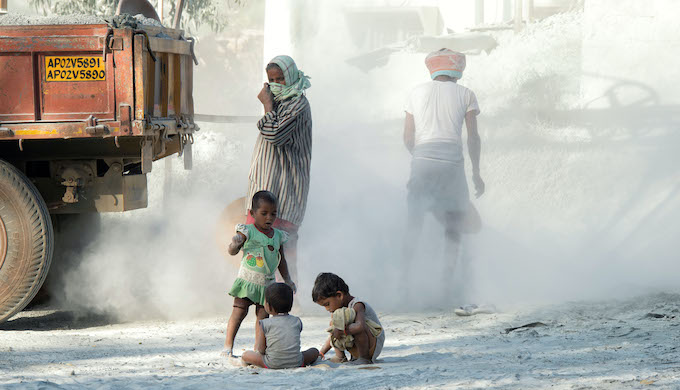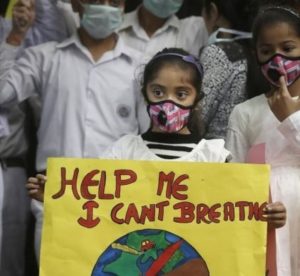1.67 million deaths due to air pollution in India, says study

Air pollution in India contributed to more than 1.67 million deaths (Image: Indiaclimatedialogue.net)
The first-ever State of Global Air 2020, a report on air pollution around the world prepared by US-based Health Effects Institute, says that long-term exposure to outdoor and household air pollution in India played a role in more than 1.67 million deaths from a variety of diseases such as stroke, heart attack, diabetes, lung cancer, and neonatal diseases last year. It also said that overall, air pollution was the largest risk factor for death among all health risks. Outdoor and household air pollution also led to premature deaths of more than 1,16,000 Indian infants in the first month of their life. More than half of these deaths were associated with outdoor PM2.5 and others were linked to use of solid fuels such as charcoal, wood, and animal dung for cooking, the report says.
Air pollution in India is not a new issue. Over the past three decades, with the sharp rise in the number of automobiles as well as increase in construction and industrial activities which generate a high degree of air pollution. According to studies, automobiles contributed to over 20 pc to air pollution in the capital New Delhi, while road dust accounted for 38 pc. Industrial, domestic and construction industry were also amongst the key sources of air pollution. While these remain more or less consistent in their share to the overall air pollution all through the year, the autumn months see a sharp spike in pollution levels as farmers all over north India turn to clearing their lands for plantation of the next crop.
Even though the government has banned the practice, for almost all the farmers the cheapest and easiest way of clearing the land setting fire to the remnants of the previous harvest in the form of stubble burning. This traditional practice has become a severe headache for the governments as well as residents of northern India as the weather conditions from October lead to a concentration of pollutants across the Ingo-Gangetic plains. In the absence of any wind, pollution from various sources remains hanging over the key cities and the stubble burning adds to the already precarious levels of pollutants in the air.
Though the governments – state as well as federal – have tried to create awareness about the dangers of stubble burning and the severe levels of pollution caused by this practice, but the farmers say they have no alternatives as the

21 of the 30 most polluted cities in the world, with the worst air quality index, are in India (Image: Fridaysforfuture India)
alternatives are either too time consuming or too expensive or even both. As most farmers, at least the small and marginal ones, continues to struggle to make ends meet, there is little scope for them to spend any money, however little, on hiring machines to get rid of the stubble. This is more so the case in 2020 as the economic crisis engendered by the coronavirus pandemic has pushed most of the smaller Indian farmers to the brink of bankruptcy.
Not just the farmers but even the governments are now skimping on alternatives to stubble burning. According to reports, owing to stretched finances of the governments, both Punjab and Haryana have cut down the number of subsidised stubble burning machines that they offer to the farmers, even though the Supreme Court has clearly asked the governments of both the states to ensure that either the subsidised machines or cash disbursement as an incentive against stubble burning is provided to the farmers at the earliest each year. Reports say that even a minor incentive of INR 3000 per acre of farm is enough to remove the threat of stubble burning entirely, a small price to pay for the health of over 200 million citizens who face severe health problems due to air pollution.
The governments need to prepare a holistic and year-long engagement plan with the farmers to ensure that at each stage, technical and financial resources needed to tackle and nip this problem in the bud are available to as many farmers as possible.
Another stop gap arrangement that the governments seem to be clinging to are the so-called smog towers, located in key areas with high density of traffic and most prone to high levels of pollution. Already a few such towers have been installed in New Delhi. The first tower was inaugurated on January 3 at Lajpat Nagar Central Market, a key shopping area in south Delhi. The tower is said to be able to purify air up to a distance of up to 750 metres, and clean upto 600,000 cubic meters of air daily, removing up to 80 pc of the PM 2.5 and PM 10 pollutants. However, most environmental experts dispute the efficacy of these towers, saying there are no studies to assess the impact of this technology on the ambient air quality. “From a public health perspective, smog towers should be thought of as the last resort,” Ravindra Khaiwal, professor of Environment Health at PGIMER Chandigarh was quoted by a daily newspaper.
While Indian governments – federal and state – keep on looking for short term solutions, which only treat the symptoms and not the cause of pollution, the severity of problem keeps on rising year after year in India. As many as 21 of the 30 most polluted cities in the world, with the worst air quality index, are in India, even as cities in China have shown continuous improvement. Ghaziabad, a satellite city of the capital New Delhi is ranked as the world’s most polluted city, with an average PM 2.5 concentration measurement of 110.2 in 2019, nine times the limit specified as healthy by the United States Environmental Protection Agency. In November last year, a public health emergency had been declared in New Delhi after the AQI levels exceeded 800 in certain parts of New Delhi.
Greenpeace says that air pollution from burning fossil fuels leads to economic losses of USD 8 billion a day or USD 2.9 trillion a year, more than 3.3 pc of global gross domestic product. Not surprisingly, China, the US and India bear the highest economic cost of soaring pollution, at an estimated USD 900 billion, USD 600 billion and USD 150 billion a year, respectively. Of the three, China has managed to take some notable steps to curb air pollution, most notably in capital Beijing which is no longer shamed as the most polluted capital city in the world, a mantle that has unfortunately been taken on by New Delhi.
If only the Indian government could also get serious about tackling this problem head on, it could not only save millions of lives but also billions of dollars in lost workdays, added healthcare and premature deaths.









